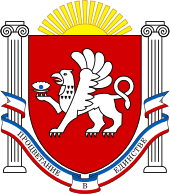Constitution of the Autonomous Republic of Crimea
| Constitution of the Autonomous Republic of Crimea | |
|---|---|
| Ratified |
October 21, 1998 (Crimea) December 23, 1998 (Ukraine) |
| Repealed | April 11, 2014[1](disputed) |
| Purpose | Establishing Crimea's status within Ukraine |
 |
| This article is part of a series on the politics and government of Crimea |
|
Republic of Crimea (within Russia)
Autonomous Republic of Crimea (within Ukraine) |
| See also |
|
Political status of Crimea Politics of Russia Politics of Ukraine |
|
|
The constitution of the Autonomous Republic of Crimea (Ukrainian: Конституція Автономної Республіки Крим Konstytutsiya Avtonomnoyi Respubliky Krym; Russian: Конституция Автономной Республики Крым Konstitutsiya Avtonomnoy Respubliki Krym) is the basic law of the Autonomous Republic of Crimea, a republic on the Crimean peninsula as part of Ukraine. The constitution establishes the republic's status and authority within Ukraine. It granted Crimea the right to draft a budget and manage its own property.[2] The constitution was repealed by a disputed referendum during the 2014 Crimean crisis, after which the Republic of Crimea was established as a federal subject of Russia after the annexation of the peninsula.[1] The Ukrainian government has refused to recognize the annexation of Crimea by Russia and still recognizes the constitution as active.
History
After a referendum on 20 January 1991, Crimea regained its status as an Autonomous Soviet Socialist Republic.[2] (Since this was months before the Declaration of Independence of Ukraine of 24 August 1991 (by December 1991 internationally recognized[3][4][5][6][7][8][9]) Crimea was at the time part of the Ukrainian SSR which was one of the constituent republics of the Soviet Union.[2][10]) In February 1992 the Crimean parliament transformed Crimea into "Republic of Crimea" and the Ukrainian government offered them more self-government.[2] On 5 May 1992 parliament declared Crimea independent[2] (which was yet to be approved by a referendum to be held 2 August 1992[11]) and passed the first Crimean constitution the same day. On 6 May 1992 the same parliament inserted a new sentence into this constitution that declared that Crimea was part of Ukraine.[11] The Ukrainian parliament convened on May 15, annulled the Crimean declaration of independence and gave the Crimean parliament one week to cancel the referendum.[11] In June 1992 the parties reached a compromise and Crimea was given the status of "Autonomous Republic".[2]
In May 1994, the Crimean parliament voted to restore the May 1992 Constitution.[2] In September 1994 President of Crimea Yuriy Meshkov and parliament decided to write a new Constitution.[2] On 17 March 1995 the Verkhovna Rada abolished the May 1992 Constitution (and the post of President of Crimea).[2] From June till September 1995 Ukrainian President Leonid Kuchma governed Crimea under a direct presidential administration decree.[2] In October 1995 the Crimean parliament adopted a new Constitution which was not recognized by the national (Ukrainian) authorities until April 1996 when significant amendments were suggested.[2] A fifth draft law of the October 1995 constitution was ratified on 21 October 1998 at the second session of the Crimean Verkhovna Rada (parliament).[2][12] The Verkhovna Rada confirmed this constitution on 23 December 1998.[12] (Article 135 of the Ukrainian Constitution provides that the Crimean Constitution must be approved by the Ukrainian parliament.)[13] It came into effect on 12 January 1999.[2]
During the Crimean Crisis, the Crimean authority repealed the 1998 Crimean Constitution after the Crimean status referendum, 2014.
Anomalies
The Crimean parliament had no right of legislative initiative.[14]
References
- 1 2 "Crimean lawmakers approve new pro-Russian constitution". Jurist.org. April 11, 2014. Retrieved December 27, 2014.
- 1 2 3 4 5 6 7 8 9 10 11 12 13 Eastern Europe, Russia and Central Asia 2004, Routledge, 2003, ISBN 1857431871 (page 540)
- ↑ Ukraine and Russia: The Post-Soviet Transition by Roman Solchanyk, Rowman & Littlefield Publishers, 2000, ISBN 0742510182 (page 100)
- ↑ Canadian Yearbook of International Law, Vol 30, 1992, University of British Columbia Press, 1993, ISBN 9780774804387 (page 371)
- ↑ Russia, Ukraine, and the Breakup of the Soviet Union by Roman Szporluk, Hoover Institution Press, 2000, ISBN 0817995420 (page 355)
- ↑ Russia's Revolution from Above, 1985-2000: Reform, Transition, and Revolution in the Fall of the Soviet Communist Regime by Gordon M. Hahn, Transaction Publishers, 2001, ISBN 0765800497 (page 482)
- ↑ A Guide to the United States' History of Recognition, Diplomatic, and Consular Relations, by Country, since 1776: Ukraine, Office of the Historian
- ↑ The Limited Partnership: Building a Russian-Us Security Community by James E. Goodby and Benoit Morel, Oxford University Press, 1993, ISBN 0198291612 (page 48)
- ↑ Ukrainian Independence, Worldwide News Ukraine
- ↑ A History of Ukraine: The Land and Its Peoples by Paul Robert Magocsi, University of Toronto Press, 2010, ISBN 1442610212 (page 722/723)
- 1 2 3 Russians in the Former Soviet Republics by Pål Kolstø, Indiana University Press, 1995, ISBN 0253329175 (page 194)
- 1 2 (Ukrainian) "Мовний" закон Колесніченка-Ківалова нічого не дав Криму "Language" law Kolesnichenko-Kivalov gave Crimea nothing, Ukrayinska Pravda (27 March 2013)
- ↑ Parliamentary Assembly - Documents - 1999 Session (First part, January 1999) - Volume I, Council of Europe, 25–29 January 1999, ISBN 978-92-871-3957-3 (page 13)
- ↑ The Crimea wants to protect majority principle, Den (7 October 2003)
Crimea prepares amendments to Constitution, ForUm (21 January 2013)
External links
| Wikisource has original text related to this article: |
- Constitution of the Autonomous Republic of Crimea (on the official site of the Verkhovna Rada of Crimea)